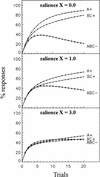A modified version of the unique cue theory accounts for olfactory compound processing in honeybees
- PMID: 12773584
- PMCID: PMC202310
- DOI: 10.1101/lm.55803
A modified version of the unique cue theory accounts for olfactory compound processing in honeybees
Abstract
We investigated the capability of honeybees to discriminate between single odorants, binary olfactory mixtures, and ternary olfactory mixtures in olfactory conditioning of the proboscis extension reflex. In Experiment 1, three single odorants (A+, B+, and C+) and three binary mixtures of these odors (AB+, AC+, and BC+) were reinforced while the ternary compound, consisting of all three odors (ABC-), was nonreinforced. In Experiment 2, only one single odorant (A+) and one binary olfactory compound (BC+) were reinforced while the ternary compound (ABC-) consisting of the single odor and the binary compound was nonreinforced. We studied whether bees can solve these problems and whether the course of differentiation can be predicted by the unique cue theory, a modified unique cue theory, or Pearce's configural theory. Honeybees were not able to differentiate reinforced from nonreinforced stimuli in Experiment 1. However, summation to ABC observed at the beginning of training contradicts the predictions of Pearce's configural theory. In Experiment 2, differentiation between the single odorant A and the ternary compound developed more easily than between the binary compound BC and ABC. This pattern of differentiation is in line with a modified unique cue theory and Pearce's configural theory. Summation to ABC at the beginning of training, however, again was at odds with Pearce's configural theory. Thus, olfactory compound processing in honeybees can best be explained by a modified unique cue theory.
Figures



Similar articles
-
Configural olfactory learning in honeybees: negative and positive patterning discrimination.Learn Mem. 2001 Mar-Apr;8(2):70-8. doi: 10.1101/lm.8.2.70. Learn Mem. 2001. PMID: 11274252 Free PMC article.
-
The effect of similarity between elemental stimuli and compounds in olfactory patterning discriminations.Learn Mem. 2002 May-Jun;9(3):112-21. doi: 10.1101/lm.41002. Learn Mem. 2002. PMID: 12074999 Free PMC article.
-
Non-elemental processing in olfactory discrimination tasks needs bilateral input in honeybees.Behav Brain Res. 2003 Oct 17;145(1-2):135-43. doi: 10.1016/s0166-4328(03)00105-0. Behav Brain Res. 2003. PMID: 14529812
-
The trial-spacing effect in olfactory patterning discriminations in honeybees.Behav Brain Res. 2007 Jan 25;176(2):314-22. doi: 10.1016/j.bbr.2006.10.019. Epub 2006 Nov 20. Behav Brain Res. 2007. PMID: 17113657
-
Commentary: Best practices for performing olfactory behavioral assays on aquatic animals: A guide for comparative physiologists.Comp Biochem Physiol A Mol Integr Physiol. 2024 Dec;298:111747. doi: 10.1016/j.cbpa.2024.111747. Epub 2024 Sep 21. Comp Biochem Physiol A Mol Integr Physiol. 2024. PMID: 39313183 Review.
Cited by
-
Antennal lobe processing correlates to moth olfactory behavior.J Neurosci. 2012 Apr 25;32(17):5772-82. doi: 10.1523/JNEUROSCI.6225-11.2012. J Neurosci. 2012. PMID: 22539839 Free PMC article.
-
Sensory adaptation modulates coding and the perceptual quality of odor mixtures.iScience. 2025 Jun 24;28(7):112999. doi: 10.1016/j.isci.2025.112999. eCollection 2025 Jul 18. iScience. 2025. PMID: 40687791 Free PMC article.
-
Multiple reversal olfactory learning in honeybees.Front Behav Neurosci. 2010 Jul 21;4:48. doi: 10.3389/fnbeh.2010.00048. eCollection 2010. Front Behav Neurosci. 2010. PMID: 20700501 Free PMC article.
-
Odor mixture training enhances dogs' olfactory detection of Home-Made Explosive precursors.Heliyon. 2018 Dec 8;4(12):e00947. doi: 10.1016/j.heliyon.2018.e00947. eCollection 2018 Dec. Heliyon. 2018. PMID: 30582032 Free PMC article.
-
Segregation of Unknown Odors From Mixtures Based on Stimulus Onset Asynchrony in Honey Bees.Front Behav Neurosci. 2019 Jul 12;13:155. doi: 10.3389/fnbeh.2019.00155. eCollection 2019. Front Behav Neurosci. 2019. PMID: 31354447 Free PMC article.
References
-
- Atkinson, R. and Shiffrin, R. 1968. Human memory: A proposed system and its control processes. In The psychology of learning and motivation: Advances in research and theory (ed. K. Spence), Vol. 2, pp. 89–195. Academic Press, New York, NY.
-
- Aydin, A. and Pearce, J.M. 1997. Some determinants of response summation. Anim. Learn. Behav. 25: 108–121.
-
- Bahçekapili, H.G. 1997. “An evaluation of Rescorla and Wagner's elemenistic model versus Pearce's configural model in discrimination learning.” Ph.D thesis. Yale University, New Haven, CT.
-
- Bitterman, M.E., Menzel, R., Fietz, A., and Schäfer, S. 1983. Classical conditioning of proboscis extension in honeybees (Apis mellifera). J. Comp. Psychol. 97: 107–119. - PubMed
Publication types
MeSH terms
LinkOut - more resources
Full Text Sources
